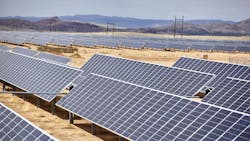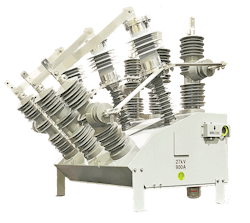According to the SEIA’s insight report, the U.S. solar market, for the third straight year, installed double-digit gigawatts (GW) of solar photovoltaic (PV) capacity in 2018. This accounted for 29% of the year’s new electric generating capacity additions, second only to natural gas, and adds to what is now 64.2 GW of total installed solar capacity – enough to power 12.3 million homes! This number is only expected to increase, as projections show the solar market doubling over the next five years, reaching an annual installed capacity of 15 GW per year.
U.S. utilities are pursuing renewable energy generation, particularly solar, for multiple reasons, some including:
- Established initiatives to pursue 100% renewable, clean energy
- Decreasing installation costs
- Investment tax credits which cover 20% of any solar installation
As solar power continues becoming more prominent and feasible for U.S. communities, utilities need solutions that allow for safe and efficient integration into the grid. As the case with most innovative technologies, this has created its own set of obstacles, including the unintended consequences that occur when connecting and disconnecting distributed energy resources (DERs) to the utility electrical grid. To minimize the impact to system stability and cost, uniquely designed solutions are required.
Utilities tasked with integrating DERs to the electrical grid face technical challenges to minimize impact to existing customers being fed by the DER-connected transmission or distribution feeder. Three areas of consideration when selecting a renewable intertie switching device are:
- Operational issues caused by increases in renewable penetration
- Costs due to power losses if the DER transformer remains connected to the utility system during evening hours when no power is being generated
- Higher than normal transformer issues that can result in premature failures
Minimizing System Voltage Sags and Extending Transformer Life
With the demand for electricity at an all-time high, and continuing to rise, power quality problems are a critical issue for utilities. Reports show that 92% of the interruptions at industrial installations are due to voltage sags, transients and momentary interruptions.
Inrush currents, which result from the energization of the DER power transformers, pose a threat to utilities by impacting power quality and potentially causing undesired protection tripping. This “magnetizing inrush” current can exceed 10 times the transformer’s rated full load current and contain significant harmonic content. This high magnitude inrush current increases the mechanical and thermal stresses on the transformer, which are higher than transformer secondary fault currents and can lead to system voltage drops and ferro-resonance issues that will negatively impact the power quality for other customers connected to the utility system.
Increasingly, solar developers are being required to meet specific power quality requirements mandated by the local utility. An internal study conducted in part by Southern States LLC discovered that one southeastern utility had experienced a voltage sag greater than 10% when a solar farm was connected to the line. The impact on other customers sharing the line led to a specification that, when connecting to a distribution line, the voltage change could not exceed 3% and that the harmonic content decay be at an acceptable level within 0.1 seconds.
To meet these requirements, solar farm developers must implement a switching method that will minimize the inrush current and resulting harmonics when connecting to the utility system.
Energy Cost Savings
The costs associated with not switching the transformer on and off are important to the owners of the DER asset. It has been estimated that, even on a small 2.5 MVA transformer, an annual savings of up to $3,000 could be achieved by disconnecting the transformer during non-power producing hours. To switch this frequently, without negatively affecting the life of the transformer, the magnetizing inrush current would need to be reduced to an acceptable level.
Switching Technologies
The following solutions are most commonly used by utilities looking to minimize inrush currents and voltage transients during transformer energization:
- Controlled Switching Technology
This solution involves utilizing a controlled switching device to switch the transformer. Controlled switching utilizes electronic controls and knowledge of residual flux of transformer core to help the switching device close on a specified point on the voltage waveform to minimize disturbances. This approach, however, depends on many variables such as control voltage, ambient temperature, mechanism wear knowledge, transformer residual flux by phase, etc. To maintain consistency, this typically expensive approach requires continued maintenance by qualified personnel to maintain reliability. Reliability of sensitive electronic controls is becoming a known issue in these remote application environments.
- Closing Resistor Technology
An alternative approach to mitigating inrush current is to utilize a closing resistor to insert resistance into the circuit prior to the main contacts of the vacuum interrupter being closed. This effectively provides a soft energization of the transformer limiting the inrush currents. If properly designed for the application, the closing resistor solution is a mechanical, highly reliable and repeatable switching solution that only involves one operating mechanism for all three phases. In addition to being easier to install, operate and maintain, this switching technology is more cost-effective compared to other solutions. Additionally, no sensitive electronics are used, hence a more reliable system.
An Innovative Solution
Southern States has been successfully applying the closing resistor technology, integrated with its SF6 switching devices, at voltages ranging from 15.5 kV to 362 kV. Their recent innovation of a vacuum switching device with closing resistors, tailored to the solar market, is now available at 15.5 kV or 27 kV, with 38kV becoming available in the near future. Compared to other switching solutions, the TranSwitcher® offers a less complex and more reliable solution to mitigating undesirable transformer inrush currents and voltage drops. This allows for more frequent switching with little impact on the utility system, extending the life of the transformer while also reducing costs associated with transformer losses.
To learn more about Southern States’ closing resistor solution, the TranSwitcher®, and how it can help solve renewable intertie challenges, click here to download their catalog flyer.
Sponsored By:


